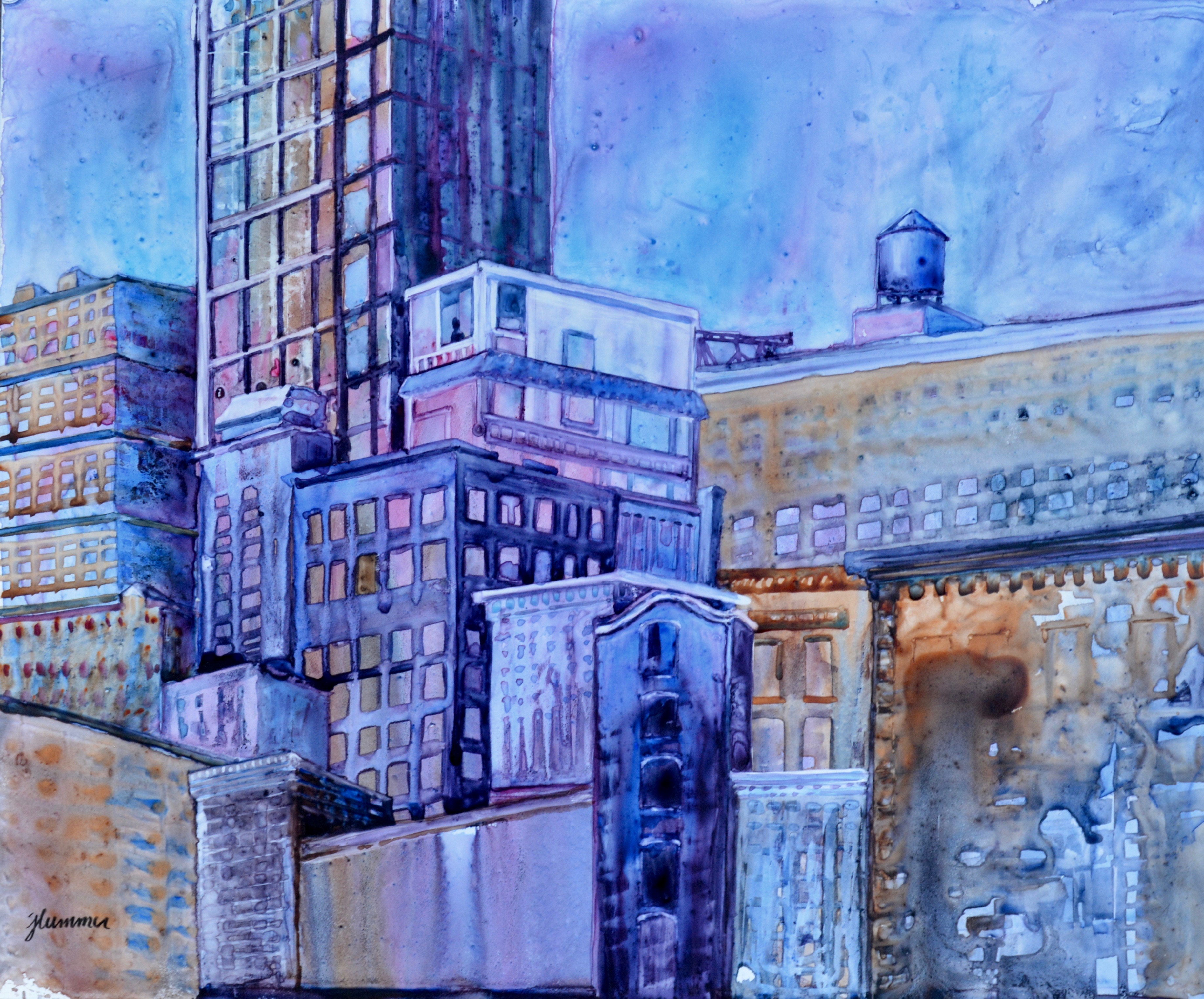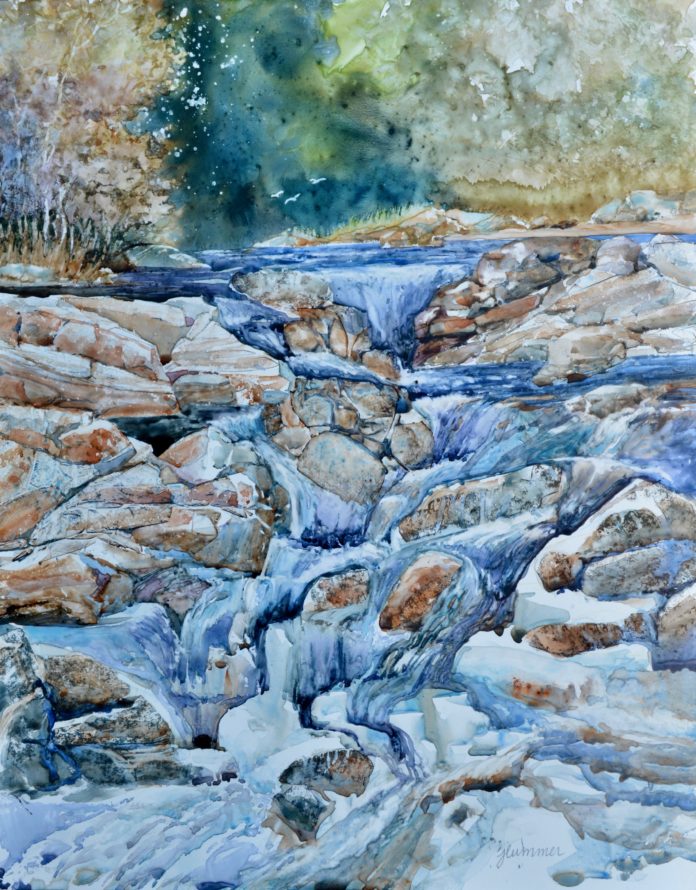Judith Hummer takes the mystery out of working with this unique synthetic surface.
“I love working with watercolor on YUPO paper,” says Judith. “I find that it pushes my skills and challenges my creativity, as I sometimes have to find unique ways to solve a problem. It also is very rewarding to achieve an interesting result from trying something new.
“YUPO is a synthetic paper made of polypropylene. The paint sits on top of the surface and does not get absorbed into the paper. The great thing about this is that you can wipe paint away to get back to the white of the paper. It also makes great textures and dripping effects.

Challenges of Working With YUPO Paper
“YUPO can have some little areas that resist pigment while painting, mostly due to the oils in our fingers from handling. This can be frustrating at first, but if you scrub the area with your brush or a tissue, that usually takes care of it, and the paint will then flow as desired. You can also clean the surface with rubbing alcohol before you begin to lessen this occurrence.
• One thing that is bothersome is the resist created from using an eraser. If you draw with a graphite pencil and need to erase a line, the area where the eraser was used will become an area of resist and will not want to receive paint. To solve this issue, I have started to draw with a watercolor pencil. If I then need to erase a line, I just use clean water and it is virtually gone.
• Another important point that people may find frustrating at first is trying to apply a glaze. Sometimes when an area needs to have the color darkened or changed, usually we just apply a thin layer or two of color over our traditional paper and call it a day. But with YUPO you have to go about this a little bit more carefully. While using YUPO, agitation will cause the paint underneath to become reactivated which disturbs the underlying passage. In order to apply a glaze without disturbing the color, you must make sure the painting is completely dry. The painting should be placed flat, no tilt. Then mix up your color on your palette; my mixtures tend to be more watery. Then, using a large brush and a gentle touch, apply the glaze over the desired area with one swipe. I tend to hold my brush at slight angle when doing this and barely apply any pressure on the paper. Do NOT go back in for a second pass; it will start to pick up the color underneath. This would be a good time to get a coffee and come back after the paint is dry to evaluate whether or not you need another pass. It is best to let the paint dry on its own rather than use a blow dryer because if the blow dryer gets too close to the paper, the heat it produces may warp the paper.

Rewards of Working With YUPO Paper
“Once you understand the little idiosyncrasies of working with YUPO, the rewards far outweigh the challenges. Texture, drips, and mark-making. That is what is so cool about YUPO – and the brilliance of the watercolors seem to bounce off the paper.
• I have achieved great-looking textures from using things that I have found around the house. Cheesecloth, cardboard insulator from my coffee cup, the end of a matchstick, among other common household things have made for some very interesting results. I have even made my own stamps by impressing designs with a dull pencil into flat styrofoam pieces. Of course wax paper and cling wrap work like a charm, too. Although water droplets sprayed in an almost dry area look fabulous.I have not been impressed with salt yet.
• Items used to stamp various marks can be used to either apply paint or remove it. To do this, the painting must be dry first. If not, the stamp will just cause a puddle and spread; it will not have sharp edges. Mix up your desired color, apply it to the stamp with your brush, press the stamp into the desired dry area of the painting, then remove it. You can also stamp with clean water to get back to the white of the paper. It is the same idea, except that instead of applying color to the stamp, you just apply clean water. Again, press the stamp onto the painting, then remove. Immediately after, lay a facial tissue over the area and then burnish it with a foam roller. If you do not have a foam roller, you can rub it gently with your hand. Pick up the tissue, and you will leave a white design behind. You can either leave it white or paint over it with another color.
• Drips! That is what YUPO is all about. This paper is fantastic for creating drips and moving the color around by tilting the board this way and that. It’s perfect for playing. I get great backgrounds this way. I feel that YUPO is a natural for achieving realistic water effects as well. To get flowing water effects — waterfalls, rivers, and streams — it is best done with the painting placed on a slight slant. Other water effects can be worked on while the board is flat.
• YUPO gives you flexibility with design. For example, if you put a rock in a river and don’t like it, you can just wipe it away and make the water flow there again. You can also alter edges and adjust shapes to make them more interesting. Wiping back to white to highlight an edge on a subject to simulate sunlight is easily achieved on YUPO.
“YUPO is a fun paper to work with, especially if you are open to letting it do its thing and seeing what happens. It can be a great way to try something out and experiment. There is no waste of paper, because if you totally hate it, you can wipe it away and try again.”
Judith Hummer is an American Watercolor Ambassador.
Become an American Watercolor Ambassador for your chance to be featured in an upcoming issue!









Great site. First time viewer. Love watercolor. My favorite medium!
Stunning Snow on Rocks! My goodness!